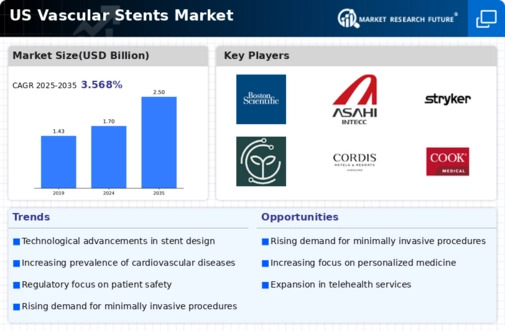Innovations in Stent Design and Materials
Innovations in stent design and materials are significantly influencing the vascular stents market. The introduction of drug-eluting stents and bioresorbable stents has revolutionized treatment options, offering improved patient outcomes and reduced complications. The vascular stents market is witnessing a shift towards advanced materials that enhance biocompatibility and reduce restenosis rates. For instance, the use of polymer-based coatings and novel metallic alloys is becoming more prevalent. These advancements not only improve the efficacy of stenting procedures but also attract investment from medical device manufacturers, further propelling market growth. As research continues to yield new technologies, the vascular stents market is likely to expand.
Rising Prevalence of Cardiovascular Diseases
The increasing incidence of cardiovascular diseases in the US is a primary driver for the vascular stents market. According to the American Heart Association, cardiovascular diseases account for approximately 697,000 deaths annually, representing about 1 in every 5 deaths. This alarming statistic underscores the urgent need for effective treatment options, including vascular stents. As healthcare providers seek to address this growing health crisis, the demand for vascular stents is expected to rise. The vascular stents market is likely to experience significant growth as more patients require interventions such as angioplasty and stenting to manage their conditions. Furthermore, advancements in stent technology may enhance patient outcomes, further driving market expansion.
Aging Population and Increased Healthcare Expenditure
The aging population in the US is contributing to the growth of the vascular stents market. As individuals age, the risk of developing cardiovascular diseases increases, leading to a higher demand for vascular interventions. The US Census Bureau projects that by 2030, approximately 20% of the population will be 65 years or older. This demographic shift is accompanied by increased healthcare expenditure, with the Centers for Medicare & Medicaid Services estimating that national health spending will reach $6.2 trillion by 2028. Consequently, the vascular stents market is poised for growth as healthcare systems adapt to meet the needs of an older population requiring stenting procedures.
Growing Awareness and Education on Cardiovascular Health
Growing awareness and education regarding cardiovascular health are driving the vascular stents market. Public health campaigns and initiatives by organizations such as the American Heart Association are increasing knowledge about the risks associated with cardiovascular diseases. This heightened awareness encourages individuals to seek medical attention sooner, leading to earlier interventions and a greater need for vascular stents. The vascular stents market benefits from this trend as more patients are diagnosed and treated for conditions requiring stenting. Additionally, healthcare providers are increasingly emphasizing preventive measures, which may lead to a more proactive approach to cardiovascular health, further stimulating market demand.
Expansion of Healthcare Infrastructure and Access to Care
The expansion of healthcare infrastructure and improved access to care are pivotal drivers for the vascular stents market. The US government and private sector investments in healthcare facilities are enhancing the availability of advanced medical technologies, including vascular stents. As more hospitals and clinics adopt state-of-the-art equipment, the vascular stents market is likely to see increased utilization of stenting procedures. Furthermore, initiatives aimed at reducing healthcare disparities are improving access to cardiovascular care for underserved populations. This trend is expected to result in a broader patient base seeking vascular interventions, thereby driving growth in the vascular stents market.





















Leave a Comment